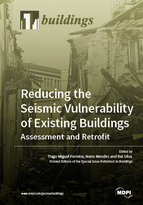Reducing the Seismic Vulnerability of Existing Buildings: Assessment and Retrofit
A special issue of Buildings (ISSN 2075-5309). This special issue belongs to the section "Building Structures".
Deadline for manuscript submissions: closed (31 March 2019) | Viewed by 54380
Special Issue Editors
Interests: multi-hazard risk analysis; risk and vulnerability reduction; seismic vulnerability; seismic rehabilitation and retrofit; urban resilience; disaster response and reconstruction; geographic information systems
Special Issues, Collections and Topics in MDPI journals
Interests: masonry structures; historical buildings; earthquake engineering; seismic vulnerability assessment; strengthening techniques; inspection; non-destructive testing; shake table tests; structural health monitoring; non-linear static and dynamic analysis
Interests: masonry structures; earthen buildings; rammed earth; compressed earth blocks; alkaline activation; sustainable building materials; strengthening and repair solutions; grout injection; numerical modelling
Special Issue Information
Dear Colleagues,
Devastating seismic events keep raising the awareness of scientific, technical and political community to the need of identifying assets at risk and developing more effective and cost-efficient risk mitigation strategies. Despite the significant advances in the field of seismic engineering and risk assessment, there is still much to be done, particularly with regard to existing buildings, most of them built without anti-seismic provisions.
The wide variety of construction and structural systems, associated with the complex behavior of their materials (raw earth, timber, masonry, steel and reinforced concrete), greatly limit the application of current codes and building standards to the existing building stock. To tackle this global issue, it is fundamental to enhance the engagement between innovation and technical stakeholders towards the development and application of more sophisticated and reliable methods of analysis, as well as improved seismic retrofitting techniques compliant with buildings conservation principles.
On the light of the exposed, this Special Issue aims at stimulating the exchange of ideas and knowledge on the assessment and reduction of the seismic vulnerability of existing buildings. To this purpose, original contributions containing fundamental and applied research, case studies or state of art discussion on the following and related topics are welcome:
Seismic Vulnerability: Origin and evolution; conceptual understanding, historic approaches and multi-disciplinary perspectives; definition of vulnerability factors; monitoring, surveying and diagnosis approaches/systems; smart digitized inventories and frameworks.
Vulnerability Assessment Methods and Tools: Empirical-based approaches; mechanical-based methods; advanced numerical simulation; large-scale assessment methods; remote sensing and GIS.
Seismic Retrofitting Techniques: Traditional and innovative strategies; cost-benefit analysis; experimental testing; development and validation; analytical and numerical simulation; application cases; post-earthquake surveying.
Dr. Tiago Miguel Ferreira
Dr. Nuno Mendes
Dr. Rui Silva
Guest Editors
Manuscript Submission Information
Manuscripts should be submitted online at www.mdpi.com by registering and logging in to this website. Once you are registered, click here to go to the submission form. Manuscripts can be submitted until the deadline. All submissions that pass pre-check are peer-reviewed. Accepted papers will be published continuously in the journal (as soon as accepted) and will be listed together on the special issue website. Research articles, review articles as well as short communications are invited. For planned papers, a title and short abstract (about 100 words) can be sent to the Editorial Office for announcement on this website.
Submitted manuscripts should not have been published previously, nor be under consideration for publication elsewhere (except conference proceedings papers). All manuscripts are thoroughly refereed through a single-blind peer-review process. A guide for authors and other relevant information for submission of manuscripts is available on the Instructions for Authors page. Buildings is an international peer-reviewed open access monthly journal published by MDPI.
Please visit the Instructions for Authors page before submitting a manuscript. The Article Processing Charge (APC) for publication in this open access journal is 2600 CHF (Swiss Francs). Submitted papers should be well formatted and use good English. Authors may use MDPI's English editing service prior to publication or during author revisions.
Keywords
- Simplified assessment methodologies
- Advanced structural modelling techniques Large-scale vulnerability assessment
- Experimental characterization
- Surveying, diagnosis and monitoring approaches
- Traditional seismic retrofitting strategies
- Development, implementation and validation of innovative retrofitting techniques








